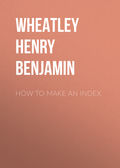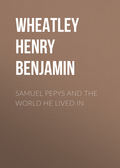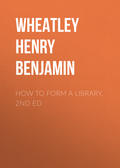
Wheatley Henry Benjamin
Prices of Books
The Chronicle of St. Albans (circa 1484), the second book printed at St. Albans, and the first edition of the Chronicle, was sold at the Earl of Ashburnham’s sale (1897) to Messrs. J. & J. Leighton for £180. It was imperfect, but no absolutely perfect copy is known.
In Quaritch’s catalogue, 1884 (No. 355), a copy with five leaves in facsimile and twenty-two others deficient, was marked £300.
The Boke of St. Albans (1486), a copy perfected in MS., was sold at the Roxburghe sale for £147. It was resold at the White Knights sale for £84. In March 1882 Mr. Quaritch bought it at Christie’s for 600 guineas. The Grenville copy now in the British Museum has gone through many vicissitudes, which were graphically described by Dr. Maitland in 1847. It appears that at the end of the last century the library of Thonock Hall, in the parish of Gainsborough, the seat of the Hickman family, was sorted out by an ignorant person who threw into a condemned heap all books without covers. A gardener who took an interest in heraldry begged permission to take home what he liked from this heap, and he chose among other books The Book of St. Albans. This remained in his cottage till June 1844, when his son’s widow sold 9 lbs. of books to a pedlar for 9d. The pedlar sold the lot for 3s. to a chemist in Gainsborough, who was rather struck by The Book of St. Albans, and tried to sell it, but the neighbours did not wish to buy it. Eventually he obtained £2, 2s. for it from a man who expected to sell it to advantage. The purchaser sold it to Stark the bookseller for £7, 7s. Stark took it to London and sold it to the Right Hon. Thomas Grenville for seventy or eighty guineas. Mr. Blades communicated this account to Notes and Queries (3rd Series, iv. 369).
A copy was sold at the Earl of Ashburnham’s sale (1897), which was stated to be the Roxburghe copy, completed by the Earl from another copy. Mr. Quaritch bought this for £385.
Still rarer than this is one of the treatises in a separate form, and printed in the next century:—
Juliana Barnes’s Treatyse of Fysshynge with an Angle. London: Wynkyn de Worde (1532). First separate edition, unique.
In the Harleian Library, afterwards in Gulston’s collection, who sold it to J. Ratcliffe, bought at his sale by White the bookseller, sold by him to Mr. Haworth, at whose sale it sold for 19 guineas (unbound). Earl of Ashburnham (1897), green morocco, £360.
A few prices may now be given of some of the most interesting publications of the old English press, consisting of the works of poets, travellers, &c., all of which have greatly increased in value, and will probably increase still more:—
King Arthur, W. Coplande, 1557.
Dent, £20, 9s. 6d., fine copy, in olive morocco by Lewis. H. Perkins (1873), £120 (same copy).
Bancroft’s (T.) Two Bookes of Epigrammes and Epitaphs, 1639. Rare Books and MSS. (Sotheby, March 1897), fine uncut copy, £42.
Barnfield’s (Richard) Encomion of Lady Pecunia, 1598.
Malone bought Farmer’s copy for 19s. Ouvry (1882), £105.
Bradshaw’s (Henry) holy lyfe and history of Saynt Werburghe (Pynson, 1521, 4o, pp. 294).
Only three copies known: (1) Gough’s, now in the Bodleian; (2) Heber’s, sold in 1834 for £19, 5s.; (3) copy in Longman’s catalogue (Bibl. Anglo-Poetica), 1815, marked £63.
The prices of Caxton’s two editions of Chaucer’s “Canterbury Tales” are recorded on a previous page of this chapter. Imperfect copies of Pynson’s first and second editions were marked £25 in Longman’s catalogue (1815). The first edition (fifty-four leaves inlaid and two leaves in facsimile) fetched at the Heber sale £60, 18s., and at the Earl of Ashburnham’s, £233. The second edition (1526) sold at the Roxburghe sale for £30, 9s., and an imperfect copy at the Ashburnham sale for £26.
Wynkyn de Worde’s edition is as valuable as a Caxton, and a fine and perfect copy sold at the Ashburnham sale for £1000.
Cutwode’s (T.) Caltha Poetarum; or, Bumble Bee, 1599.
Three copies only known: (1) Malone’s, now in the Bodleian; (2) Heber’s, from which the Roxburghe Club reprint was made, sold in 1834 for £3, 18s.; (3) a copy which belonged successively to Steevens, Caldecott, and Freeling. Steevens’ sale (1800), £2, 12s. 6d.; Freeling (1836), £11, 15s.
According to Ritson, this book “was staid at the press by order of the Archbishop of Canterbury and Bishop of London; and such copies as could be found or were already taken were to be presently brought to the Bishop of London to be burnt.” Dibdin gives an amusing account of the Roxburghe Club reprint (1815) in his “Reminiscences” (vol. i. p. 465, note):—“A bet was laid (the winner of the bet to give the Roxburghe Club a dinner) between Sir M. M. Sykes and Mr. Dent whether the anniversary meeting of 1815 was the third or fourth of the club. Mr. Dent was the loser, when Mr. Heber promised to present the club with a reprint of the above poem at the extra dinner in contemplation. Only nine days intervened, but within that period the reprint was transcribed, superintended at the press by Mr. Haslewood (without a single error), bound by Charles Lewis, and presented to the members on sitting down to dinner. Mr. Haslewood was reported to have walked in his sleep with a pen in his hand during the whole period of its preparation.”
Drummond of Hawthornden’s Forth Feasting, 1617, bought by Ouvry at Sotheby’s in 1858 for £8, 15s. (bound in morocco), fetched £60 at Ouvry’s sale in 1882.
Fabyan’s Chronicles (Pynson, 1516), first edition.
Dr. F. Bernard (1698), 4s. 8d.
Roberts (1815), £84—North. John North (1819), £92. (Perfect.)
Samuel Lysons (1820), £35—Lord Aylesford. Lord Aylesford (1888), £250—Christie Miller. (Completed by leaves from another edition.)
Foxe’s Acts and Monuments (John Daye, 1562-63), first edition, complete.
Earl of Ashburnham (1897), £150.
Frobisher’s Three Voyages of Discoverie, 1578, with Keymis’s Second Voyage to Guiana, 1596, in one vol., calf gilt, by Kalthoeber.
Beckford (1882), £300.
Ouvry’s copy of Frobisher, wanting the maps, sold for £68.
Froissart’s Cronycles (Pynson, 1523-25), two vols. folio.
G. Mason (1798), £36, 15s. Roxburghe (1812), £63. Towneley (1814), £42 (title of vol. i. a reprint). W. H. Crawford (Lakelands), 1891, £25.
Hakluyt’s Principal Navigations, Voiages and Discoveries of the English Nation, 1589, with rare map, fine copy, in pigskin.
Jadis, £26, 5s. Same copy, Duke of Hamilton (1884), £23.
Hariot (T.), Merveilleux et estrange Rapport … Francofurti, 1590.
Duke of Hamilton (1884), fine copy, in morocco by Lewis, £97.
Linschoten’s Voyages into the Easte and West Indies, 1598, maps and plates from the Dutch edition, title inlaid, and last leaf mended.
Roxburghe, £10, 15s. Same copy, Beckford (1882), £14. Colonel Stanley, £22.
Lodge’s (Thomas) Rosalynde, 1598.
Longman (1815), £20 (imperfect). Heber, £5, 10s. Ouvry (1882), £63.
Lok’s (Henry) Ecclesiastes (London: Richard Field, 1597).
Longmans (1815), £28. Sotheby’s (March 1817), £6, 16s. G. Daniel, £38, 10s.
The first editions of Milton’s works have greatly increased in price. Not many years ago a copy of the first edition of the “Paradise Lost” could be obtained for about five pounds, but now a good copy is worth at least four times as much. The prices vary considerably with the date of the title-page, of which there are several issues. G. Daniel’s fine copy sold in 1864 for £28, 10s.
Milton’s Maske (Comus), 1637.
Loscombe, £25. G. Daniel, £36.
–– Poems, 1645, first edition, with portrait by Marshall.
G. Daniel, £5, 15s. Rare Books and MSS. (Sotheby, March 1897), fine uncut copy, £24, 10s.
Purchas his Pilgrimes, five vols., 1625-26.
Digby (1680), £3, 5s. 6d. H. Perkins, 1873, fine copy, £86. Beckford, 1883, fine copy, £63. Earl of Gosford (1884), £82 (crimson morocco). Earl of Crawford (1887), £60.
Rhodes (Hugh), Boke of Nurture, 1577.
Steevens (1800), £2, 2s. Longmans (1815), £15.
Ricraft’s Peculiar Characters of the Oriental Languages, sm. 4to.
Bindley, £19, 19s. Same copy, bound afterwards in russia extra by Lewis, who charged £1, 5s. for the binding, sold in Beckford sale (1883) for £8, 17s. 6d.
Scot’s Discoverie of Witchcraft, 1584.
Boswell, £3, 3s. Comerford (1881), £25, 10s. (citron morocco).
It is interesting to notice that in the old sales of the seventeenth century the folios of Shakespeare, Beaumont and Fletcher, and Ben Jonson all sold for about the same price. Those of the first now sell for one hundred and two hundred times what they brought then, while those of the second and third do not bring ten times.
Beaumont and Fletcher’s Works, 1647.
Sir Edward Bysshe (1679), 13s. 6d. Smallwood (1684), 8s. A. Young and others (Puttick’s), 1875, £5. Alfred Crampton (1896), 10 guineas.
Jonson’s (Ben) Works, 1640.
Benj. Worsley (1678), £1, 13s. 6d. Sir Edward Bysshe (1677), £1, 10s. Lord Bateman (1896), £8, 5s.
Spenser’s Faerie Queene, 1590-96, first edition.
Sir Edward Bysshe (1679), 6s. 2d. Lloyd and Raymund (1685), 1s. Ouvry (1882), £33. Alfred Crampton (1611), 1896, with additional leaves, £85.
Weever’s Funeral Monuments, 1631.
Two copies on large paper in Beckford’s sale, part 4 (1883), olive morocco, index inlaid, £25; blue morocco, £38.
Wycliffe.
Mr. Addington bought at the Dix sale four unique tracts of Wycliffe for £400, and expressed his opinion that they would have been cheap at any price, but at his own sale (1886) they only realised £133—viz., Crede, &c., £37; Consolation, £27; Testament of Moyses, £36; Small Prayers to Common People, £33.
Americana is a class of book which has grown enormously in price. Anything published in America in the seventeenth and eighteenth centuries now fetches a price.
Smith’s Virginia, 1624.
Dr. F. Bernard (1698), 4s. 2d. Hunter (1813), £27, 6s.
A large paper copy sold at the Beckford sale (1883) for £605 (dedication copy to the Duchess of Richmond, in old brown morocco, covered with gold tooling, with the Duchess’s arms forming the centre ornaments).
Eliot Bible of 1661-63.
Dr. L. Seaman (1676), 19s. Wimpole library (Lord Chancellor Hardwicke), 1888, £580—Quaritch.
At this Wimpole sale (Christie’s) a volume of twelve tracts of the sixteenth and seventeenth centuries relating to America sold for £555.
A curious incident occurred at Messrs. Sotheby’s in July 1897, during the sale of the library of Mr. Cyril Dunn Gardner. A volume of Sermons, which included “A Sermon preached at Plimmoth in New England, Dec. 9, 1621,” was put up, and the biddings, commencing at 5s., were carried on till £1, 17s. was reached, when the lot was knocked down at that amount. A dispute arising, it was put up again, and was eventually bought by Messrs. H. Stevens and Son for £87.
CHAPTER X
PRICES OF SHAKESPEARE’S WORKS
The first edition of Shakespeare’s Plays (folio, 1623) has been rising in price from the commencement of the nineteenth century; but the enormous prices now paid do not date further back than 1864, when a specially fine copy was bought by the Baroness Burdett-Coutts at George Daniel’s sale for £716, 2s. This amount was paid on account of the height of the book and of its great beauty, and possibly the circumstance of the year being the tercentenary of Shakespeare’s birth had something to do with it, but this sale had the effect of raising the price of all copies permanently.
Beloe, writing in 1807 (“Anecdotes,” vol. i. p. 36), said, “Perhaps there is no book in the English language which has risen so rapidly in value as the first edition of the works of our great national poet. I can remember a very fine copy to have been sold for five guineas. I could once have purchased a superb one for nine guineas.” This statement can be corroborated; for the Cracherode copy in the British Museum, one of the few really fine copies, has the price £8, 18s. 6d. marked in it. Richard Wright’s copy sold in 1787 for £10, Allen’s in 1795 for 18 guineas. Farmer’s copy (wanting title, and with the last leaf in MS.) sold for £7. Garrick bought his copy from Payne for £1, 16s. Jolley obtained it at Garrick’s sale in 1823 for £34, 2s. 6d., and at Jolley’s sale in 1844 it realised £84. Lord Denbigh’s fine copy sold in 1825 for £89, 5s., and Broadley’s in 1832 for £51; William Combes’s copy (wanting title-page and all prefatory leaves, but with the text of the Plays complete) fetched 8 guineas in 1837; Bright’s copy (1845), with title repaired, verses from another edition, and some leaves inlaid, brought £31, 10s. The Stowe copy (1849), with verses inlaid, £76; Hawtrey’s (1853), with some leaves mended, £63. In 1824 Mr. Thorpe the bookseller advertised a set of the four folios—first, £65; second, 10 guineas; third, £25; and the fourth, 6 guineas, or the four for £100. About the same time Mr. Pickering marked a similar set £95.
Copies of the first folio are so constantly sold that one might suppose it to be a common book, but this may be accounted for by the fact that they are constantly changing hands. There are only a few copies absolutely perfect, but others are made up from various copies, or with pages in facsimile. This makes the most imperfect copies of value, because they can be used to perfect others.
Dibdin described thirty copies of the first folio in his “Library Companion,” and these he arranged in three classes. In the first class he placed three copies, belonging respectively to Mr. Cracherode, the Right Hon. Thomas Grenville, and Mr. Daniel Moore. The first two are now in the British Museum, and the third is the Daniel copy, for which Lilly the bookseller offered £300.
“These have size, condition, and the genuine properties of a true copy. They are thirteen inches in height, eight and a half in width, have the true portrait and title-page, with the genuine verses in the centre of the leaf facing the title-page. They have no spurious leaves foisted in from other editions.... Of these three copies, that in the Cracherode collection is the most objectionable, as the commendatory verses of Ben Jonson, facing the title-page, are, although genuine, inlaid.”
Mr. Grenville’s copy was bought at Saunders’s sale in 1818 for £121, 16s., which was then thought to be a great sum, and Dibdin makes the unfortunate prophecy that this was “the highest price ever given, or likely to be given, for the volume.” Mr. Grenville told Dibdin that an ancestor of Sir Watkin Williams Wynn possessed an uncut copy of the first folio. “It was lying on the table in that condition when, in a luckless moment, a stationer in the neighbourhood of Wynnstay came in. The book was given to him to be bound, and off went not only the edges, but half of the margins.” Another piece of vandalism was the inlaying the leaves of the book and binding them in three volumes. This was Henderson the actor’s copy, which sold at Reed’s sale for £38. In the second class were included some very good copies.
“Lord Spencer’s copy had every leaf picked by the experienced hands of the late George Steevens. The verses opposite are genuine, but inlaid, and there are many tender leaves throughout. There are also in the centre of some of the pages a few greasy-looking spots, which might have originally received the ‘flakes of pie-crust’ in the servants’ hall, as notified by Steevens.54 But it is a beautiful and desirable copy.”
The price mentioned by Steevens is that which the Duke of Roxburghe gave for his copy in 1790, respecting which Dibdin relates an anecdote that took his fancy so much, that he tells the story both at the beginning and at the end of his Bibliomania.
“A friend was bidding for him in the sale-room: his Grace had retired to a distance to view the issue of the contest. Twenty guineas and more were offered from various quarters for the book: a slip of paper was handed to the Duke, in which he was requested to inform his friend whether he was ‘to go on bidding.’ His Grace took his pencil and wrote underneath, by way of reply—
‘Lay on, Macduff;
And d—d be he who first cries, “Hold, enough!”’
Such a spirit was irresistible, and bore down all opposition. His Grace retired triumphant, with the book under his arm.”
A rather different version of this story of Nicol’s purchase for the Duke is given in Martin’s “Privately Printed Books.”
This copy sold at the Roxburghe sale for £100, and is now in the Duke of Devonshire’s library. Dibdin had a commission from Sir Mark Masterman Sykes to give £75.
Hibbert’s copy was pronounced by Mr. Amyot to be the best copy he had seen after those placed in the first class. It belonged to “Dog” Jennings, and was purchased of Mr. Payne for 70 guineas. At Hibbert’s sale it fetched 81 guineas, and was resold in 1847 at Wilks’s sale for £155. It again occurred at Dunn Gardner’s sale (1854), when it was bought by Mr. H. Huth for £250.
Dent’s copy was a tall copy, identical in measurement with Daniel’s, and with some rough leaves, but the title and verses were pasted down. It was bought by H. Perkins for £110, 5s., and at Perkins’s sale it realised £585, 10s.
John Kemble’s copy was inlaid on large paper, and bound by Mackinlay. It was purchased by Mr. Boswell for £112, 7s., and at his sale it brought £105.
In the third class are the following:—
Steevens’s copy was given to him by Jacob Tonson in 1765, and it had passed through the hands of Theobald and Dr. Johnson, the “latter not having improved its condition.” It wants the title and portrait, the latter being supplied by a facsimile drawing by Steevens. The verses are from the second edition. Dr. Charles Burney bought this at the sale of Steevens’s library for £22. It is now in the British Museum. Nassau’s copy was perfect, with the exception that the verses were from the second edition. It was bought by Mr. Thorpe for £49, 7s.
E. V. Utterson’s copy was fair, with title and portrait mounted, verses inlaid, and several leaves mended. It sold for £49 in 1852.
Colonel Stanley’s copy was in fair condition, but wanted the original verses and title-page. It was bought at Stanley’s sale by Mr. North for £37, 16s., and at North’s sale it realised £39, 18s.
Heber gave 10 guineas for his copy, which wanted verses, list of actors, &c., title a reprint from the second edition, some leaves stained, and others mutilated. This sold at Heber’s sale (1834) for £57, 15s.
A copy of the first folio is now looked upon as a necessary addition to a first-class library, but there was no copy in the libraries of the Earl of Oxford, Dr. Mead, West, Askew, Crofts, Beauclerk, Heath, Willett, Bindley, or in the Sunderland or Hamilton Palace libraries.
Mr. Robert Holford is said to have given £250 for his tall copy.
The following is a list of some of the copies which have been sold since the famous Daniel copy:—
In 1882 Beresford-Hope’s copy, with verses inlaid, title repaired, in morocco by Clarke, fetched £238; and Ouvry’s sound copy, in red morocco by Clarke and Bedford, sold for £420.
The Earl of Gosford’s copy, perfect, with title and verses mounted, and margins of leaves slightly mended, was sold in 1884 for £470.
Hartley’s copy was in poor condition, although very tall (13⅜ by 8¾), title with portrait wanting, page with verses mutilated, and some leaves mended. It sold in 1887 for £255. Hartley gave £500 for it to those who had bought it at a knock-out for £75.
The Earl of Aylesford’s copy, wanting title, with verses from second edition, and five leaves stained, sold in 1888 for £200.
In 1889 F. Perkins’s copy, with title and verses mounted, sold for £415; and Halliwell Phillipps’s poor copy, with portrait, verses, preliminary and last leaf in facsimile, for £95.
W. H. Crawford’s imperfect copy, with title, verses, prefatory matter, and “Cymbeline” reprinted in facsimile, sold in 1891 for £16, 10s.
In this same year Brayton Ives’s copy, perfect, but rather short, was sold in New York for 4200 dollars (£840).
Addington’s copy, with verses inlaid, in good condition, but short (12⅝ by 8¼), fetched £280.
A copy, with title in facsimile, leaf containing verses, last leaf and a few others mended in the margin, was sold in a sale of Early English Poetry (Sotheby, 1892) for £208.
Birket Foster’s copy sold in 1894 for £255; and Mr. Toovey’s, with title and verses in facsimile, for £169.






